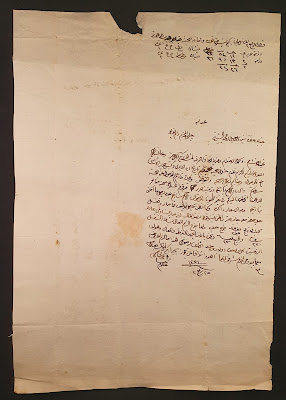This is a priceless antique English plate decorated with Malay / Jawi motif & pantun (poems). This plate was manufactured by Williams Adams & Sons company sometime between 1819 CE to 1864 CE. This company was established in the early nineteenth century and great supplier of wares to India & the Far East. The trademark can be seen at the bottom of this plate, written W. Adams And Son under a medallion inside which is inscribed the name of the motif viz MALAY.
"The plate was printed using the process of transfer-printing, which was first used in England around 1750. The design is engraved on a metal plate, then impressed on a thin piece of paper, and transferred to the surface of the pottery or porcelain."
The pantun inscribed on the rims written :
" Yang membuat namanya Adam,
wakilnya Tolson di Betawi,
Syair dan pantun banyaklah ragam,
Janganlah tuan kikir membeli"
Anderson Tolson is probably a retailing firm in Batavia.
The pantun inscribed 4 lines in the centre written :
Papan di tarah raja bangsawan
Laksamana mandi berdiri
Badan terserah padamu tuan
Tiada ke mana membawa diri
There is an interesting research & article written by Henri Chambert-Loir from Almanac Indonesia & The Malay World in regards to the this type of plate. It was quite extensive research and dug further to its origin and its design. The handwriting print on this plate belongs to Khatib Muharis. Even though his name is not printed on this plate, there are others with the same handwriting bearing his name. Diameter of this plate is 22cm
In the book, Piring Puisi Melayu, Abu Muawiyah classified the piring as PPM-E3 on page 303.
See below link to see what else Dr Henri said about this plate writing tradition :
Dr Henri talk on pinggan pantun
Similar plate was seen in Muzium Warisan Melayu UPM, check below link about this plate :
Pinggan Pantun in Muzium Warisan Melayu
I have quite similar design of this plate below :
See below my other Malay Plate
Reference :
Eating the text : English plates decorated with Malay poems, by Henri Chambert-Loir ( published in Indonesia & The Malay World 1994)
Piring Puisi Melayu, by Abu Muawiyah, Maktabah Nasir Addunya Waddin
Crescent Moon : Islamic Art & Civilisation South East Asia, pg 78













